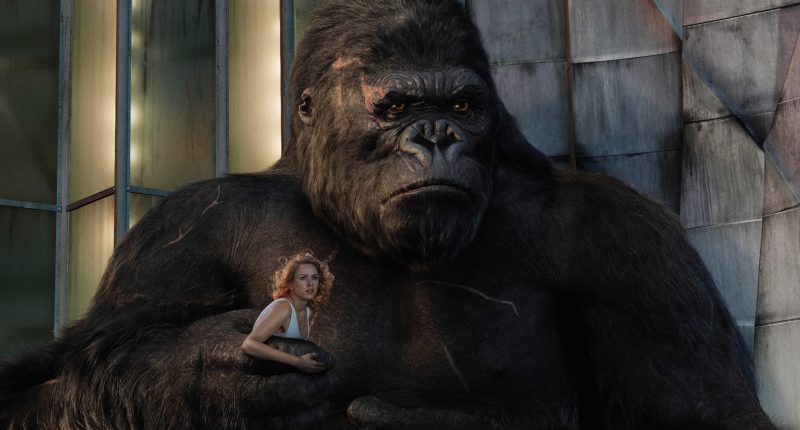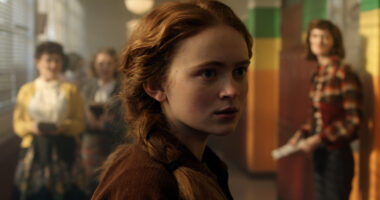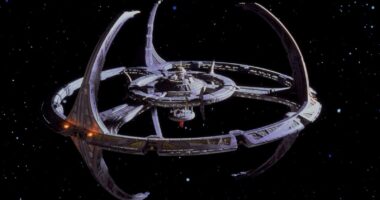Share this @internewscast.com
Cinema has introduced us to many incredible monsters, but one giant ape has captivated audiences for almost a hundred years. King Kong is a unique figure in film, and no matter how many retellings his story receives, viewers consistently return for more.
The tale of King Kong’s creators begins in the era of World War I and comes to life in Hollywood. Director Merian C. Cooper conceptualized the character, while animator Willis O’Brien gave him form. This creation has featured in 13 films, spanning live action and animation, and remains just as significant today. If you want to see the highlights of the franchise, check out our King Kong movie rankings. However, if you’re intent on experiencing everything, we suggest starting from the earliest films and working your way through to the latest installments. Here’s how that cinematic journey unfolds:
-
“King Kong” (1933)
-
“Son of Kong” (1933)
-
“King Kong vs. Godzilla” (1962)
-
“King Kong Escapes” (1967)
-
“King Kong” (1976)
-
“King Kong Lives” (1986)
-
“The Mighty Kong” (1998)
-
“Kong: King of Atlantis” (2005)
-
“King Kong” (2005)
-
“Kong: Return to the Jungle” (2006)
-
“Kong: Skull Island” (2017)
-
“Godzilla vs. Kong” (2021)
-
“Godzilla x Kong: The New Empire” (2024)
Why is that the correct order to watch King Kong movies?
The “King Kong” film series occupies a distinctive niche. The original movie debuted nearly 100 years ago, yet the franchise lacks a cohesive narrative thread. About a third of the Kong movies retell the initial story, and his collaborations with Godzilla often share similar storylines too. Watching the entire series means you’ll encounter numerous repeated scenes and motifs.
The good news is that the repetition is really the reward here. Watching the entire franchise in chronological order lets you see how Kong as evolved as a character, and it also gives you an interesting look on how Kong’s original story has shifted in different cultural moments. The 1933 film and the 2005 remake technically tell the same story, but Peter Jackson’s three-hour epic is quite a different experience from the old black and white picture. If you aren’t committed to watching every movie in the series, we have some alternate order suggestions to cover later, but watching the entire franchise chronologically can be a really rewarding experience.
King Kong (1933)
It’s difficult to imagine what it was like to see “King Kong” in 1933. The original film debuted to a New York City theater audience and seared itself into the public imagination for decades to come. Directed by Merian C. Cooper and Ernest B. Shoedsack, “King Kong” was a revolutionary film for the time. It used an incredible combination of practical special effects and stop-motion animation to create action sequences that were, at the time, almost unimaginable for most audiences.
The story follows an actress named Ann Darrow (Fay Wray) working on a new picture with director Carl Denham (Robert Armstrong). They travel to Skull Island to film on location, but there the locals kidnap Ann and prepare to sacrifice her to the massive King Kong. Eventually Ann is freed, Kong is captured, and the entire production moves back to New York. There Kong escapes and begins his iconic climb up the Empire State Building — and into cinematic immortality.
Son of Kong (1933)
Any film fan can tell you about the time that King Kong climbed the Empire State Building, but fewer people can tell you what the great ape’s son was up to at the time. “King Kong” was a massive success when it debuted in 1933, and the movie’s sequel got fast-tracked and released that very same year. Just nine months after seeing “King Kong,” audiences were catching up with everything that happened in the aftermath of his rampage through New York City, and it turns out that wasn’t quite enough time to make a great sequel.
This movie focuses on Carl Denham from the first film,with Robert Armstrong returning to play the role. Denham is facing all kinds of legal trouble and public scrutiny after bringing a giant, destructive ape into the big city. He ends up returning to Skull Island in search of a lost treasure, encountering a smaller ape that Denham believes could be Kong’s son. Little Kong doesn’t make it back to the States, but he and Denham develop a unique bond while trying to stay alive on Skull Island. Unfortunately, their exploits didn’t make as much of an impact as the first movie did. “Son of Kong” disappointed audiences and critics alike, and that might be why it was the last time Kong showed up on the big screen for decades.
King Kong vs. Godzilla (1962)
After “Son of Kong,” it seemed like the “King Kong” franchise was dead and buried. Then the character came roaring back in the 1960s with the Ishirō Honda film “King Kong vs. Godzilla.” The movie actually began as an idea titled “King Kong vs. Frankenstein,” which was developed by original “King Kong” animator Willis O’Brien. Sadly that exact movie never became a reality, but the idea of a big screen battle was carried over to Japan where Honda — director of numerous “Godzilla” movies — jumped on it.
“King Kong vs. Godzilla” brought both characters into full color for the very first time. It also changed Kong’s look in a pretty significant way. Instead of stop-motion, Honda’s movie relies on costumes and miniaturized sets to bring its characters to life. In the movie, a pharmaceutical executive wants to capture King Kong and use the creature to boost publicity for his company. It just so happens that around the same time an American submarine accidentally crashes into an iceberg and frees Godzilla from dormancy. As the giant lizard starts attacking Japan, Kong has an opportunity to become a hero — and he defeats Godzilla decisively, despite rumors to the contrary.
King Kong Escapes (1967)
“King Kong Escapes” is the second movie about the great ape directed by Ishirō Honda. Despite having the same director as “King Kong vs. Godzilla,” the 1967 movie essentially exists in its own universe. The plot does have some similarities with the anime “The King Kong Show,” which began airing in 1966 and features King Kong meeting all sorts of bizarre characters, from mad scientists to other giant monsters.
In this movie, an evil scientist called Dr. Who (Hideyo Amamoto) has created a robotic version of King Kong that he calls Mechani-Kong. Dr. Who wants to use Mechani-Kong to retrieve a dangerous mineral called Element X from the North Pole, but unfortunately radiation from the element destroys part of Mechani-Kong’s brain. Dr. Who decides to retrieve the real Kong as a backup plan, but naturally that also doesn’t turn out the way the mad scientist intended. By the end of the film, Kong and Mechani-Kong are duking it out and continuing the theme of giant monster battles that all of Honda’s kaiju films were famous for.
King Kong (1976)
Not quite 50 years after “King Kong” made history, Paramount Pictures tried to do it all over again. The studio worked with producer Dino De Laurentiis and director John Guillermin to create an updated version of the original movie that brought King Kong into the 1970s. In the movie, Fred Wilson (Charles Grodin) is an oil executive who organizes an expedition to a mysterious undiscovered island in the Indian Ocean. Jack Prescott (Jeff Bridges) is a paleontologist who tries to warn the expedition about reports of a terrible beast on the island. During the journey, the crew encounters a life raft carrying an actress named Dwan (Jessica Lange) who had been on a director’s yacht near the island before it sank.
Once all those characters are established and set on the path to Skull Island, the movie mostly hits the same beats as the original. King Kong eventually gets captured and brought back to New York City, but this time when he escapes he climbs the World Trade Center with Dwan in his hands. Likely because the movie didn’t bring much new to the franchise, 1976’s “King Kong” isn’t particularly well-remembered. The film might have a great cast, but it isn’t well-regarded amongst critics or Kong fans.
King Kong Lives (1986)
Dino De Laurentiis and John Guillermin teamed up a second time to produce a sequel to their “King Kong” remake. The titular ape might have died at the end of the first film, but that’s nothing a simple retcon can’t fix. “King Kong Lives” continues Kong’s story, but unfortunately it also continues the franchise’s tradition of having lackluster sequels. According to most critics and viewers, “King Kong Lives” is even worse than “Son of Kong” and just might be the worst movie in the entire franchise.
The movie begins by revealing that Kong didn’t die at the end of “King Kong.” Instead, scientists at the Atlantic Institute have been keeping him in a coma for a decade. Now, though, Kong needs a heart transplant and blood transfusion or he’s going to die. While trying to save Kong’s life, the scientists discover a female ape that gets nicknamed Lady Kong. Thanks to Lady Kong, the scientists are able to perform the necessary operations on Kong, but then the two apes escape the facility together. The relationship between the Kongs is the real centerpiece of the movie, but it’s not nearly as compelling as what any of the earlier “King Kong” movies had to explore.
The Mighty Kong (1998)
There have been several remakes of “King Kong” over the years, but none of them are quite as strange as “The Mighty Kong.” Released in 1998, the movie’s plot is an almost exact recreation of what happened in the 1933 film. Ann Darrow (Jodi Benson) and Carl Denham (Dudley Moore) are back as the main characters, and their attempt to make a major motion picture causes them to cross paths with Kong. Just like in the original, they bring Kong back to the States, and he carries Ann up the Empire State Building.
“The Mighty Kong” is the first feature-length animated film in the franchise, but that’s not even the movie’s strangest claim to fame. What really sets this installment apart from everything else in the “King Kong” universe is that it’s a musical. If you’ve ever wanted to see Kong singing and dancing his way through the Big Apple, here’s your chance. “The Mighty Kong” never reached the heights of any other movie in the franchise, but it’s definitely one of the strangest takes on the story we’ve seen.
Kong: King of Atlantis (2005) / Kong: Return to the Jungle (2006)
Amidst the sea of “King Kong” franchise content, you can be forgiven for overlooking “Kong: The Animated Series.” The cartoon debuted in 2000, and in less than a year it aired two different 20-episode seasons. The series follows a man named Jason Jenkins (Kirby Morrow) whose grandmother creates a clone of Kong after the great ape falls from the Empire State Building in the original story.
“Kong: King of Atlantis” was the second feature-length animated Kong movie and the first tie-in film for the animated series. The city of Atlantis has reemerged, and Queen Reptilla has an evil scheme that involves making Kong the new ruler of the underwater empire. A year later fans of the show also got “Kong: Return to the Jungle.” That movie’s plot follows Kong as he’s kidnapped and taken to a special zoo. For the first time in his life, Kong has to pretend to be a fairly normal wild animal until his friends can find and rescue him.
King Kong (2005)
If you thought one remake and a musical would be enough for “King Kong,” then you were wrong. In 2005 the world got another remake of the original film, but this one stood out in a number of ways. 2005’s “King Kong” has an all-star cast including Naomi Watts, Adrien Brody, and Jack Black, with Andy Serkis doing motion capture for Kong himself. The movie also has “The Lord of the Rings” filmmaker Peter Jackson in the director’s chair, and Jackson’s penchant for visually epic shots absolutely comes through.
Jackson’s sense of scale affects more than just the landscape shots of Skull Island. The movie’s runtime, at three hours and seven minutes, is gargantuan, as is its budget. The film cost over $200 million to produce, and Jackson went so far over budget that he had to pay $20 million personally to get the final product completed. At the time, it was one of the most expensive movies ever made, but that investment paid off. “King Kong” made over half a billion dollars at the box office, and with a total of three Oscar wins, it remains one of the most critically celebrated films in the entire franchise.
Kong: Skull Island (2017)
The 2000s got a “King Kong” remake, but Peter Jackson’s take on the story didn’t kick off a new era for Kong as a character. Instead that honor falls to 2017’s “Kong: Skull Island.” Directed by Jordan Vogt-Roberts, “Skull Island” was another attempt to reboot Kong’s story with a slightly different spin. Instead of carrying Kong to New York, this movie takes place entirely on the titular island and goes out of its way to establish Kong as part of a cinematic universe.
Initially, “Skull Island” is nothing but a classic Kong tale. Bill Randa (John Goodman) leads a group called Monarch that studies global mysteries like giant creatures and the possibility of a secret Hollow Earth beneath the surface of our everyday world. Bill wants to lead an expedition to Skull Island to map out the unexplored territory, but there he and his team discover a whole world of dangerous animals and evolutionarily unique creatures.
The movie mostly focuses on the members of Bill’s expedition fighting for their lives against the dangerous native animals of Skull Island, but along the way they meet Kong and discover that he has the potential to be a powerful ally to all of humanity. “Skull Island” didn’t receive the same critical acclaim as Jackson’s 2005 movie, but it had a bit more popular appeal and became the second “King Kong” film to break the half billion mark at the box office.
Godzilla vs. Kong (2021)
Almost 50 years after the two of them had their first on-screen interaction, King Kong and Godzilla were clashing once again in the aptly named “Godzilla vs. Kong.” This movie builds on the Monsterverse premise that was set up in 2014’s “Godzilla,” “Kong: Skull Island,” and 2017’s “Godzilla: King of the Monsters.” The good news is that “Godzilla vs. Kong” is easy to jump into even if you haven’t seen the connecting films, and in a way, this crossover movie is the first true Monsterverse film.
The world is still reeling from a battle between Godzilla and King Ghidorah that took place five years earlier and awakened giant monsters called Titans across the globe. With the entire planet thrown into chaos, Monarch is using its research into Titans and the Hollow Earth to try and find a way to save humanity.
“Godzilla vs. Kong” greatly expanded the Monsterverse and snuck in plenty of small details you only notice on a second viewing. Of course, the movie also packed plenty of Titan fights amongst the lore dumps, and that’s why it was a hit both financially and critically. Fans of both Godzilla and King Kong were happy with the movie, and once the sequel was announced, they were delighted to learn that they wouldn’t need to wait decades before seeing the Titans on screen together again.
Godzilla x Kong: The New Empire (2024)
Just three years after “Godzilla vs. Kong” pit the legends against each other, “Godzilla x Kong: The New Empire” brought them together again. This time around the story heavily focuses on Kong, and we catch up with him after his battle against Mechagodzilla in the previous film. Kong has established a peaceful life for himself in Hollow Earth, but one day a sinkhole opens in the ground, leading Kong to discover an even more secret kingdom beneath the Earth’s surface. There he encounters a whole tribe of his own species, but Kong quickly realizes that his people don’t have good plans for the world above.
“The New Empire” continues to build on the interconnected Monsterverse established in the previous films, and your enjoyment of it might hinge on how invested in that world you are. Critically, the movie was a flop with just a 54% rating on Rotten Tomatoes. On the other hand, “Godzilla x Kong” is the highest-grossing movie in the franchise, and fans gave the film an 89% score. For some devotees, this might be the pinnacle of what King Kong has to offer.
What are other ways to watch the King Kong movies?
Obviously King Kong has a long history, but you don’t necessarily need to watch the movies in chronological order. It can be helpful to break the franchise into several mini-series, separating the original films from the Japanese Toho productions from the modern Monsterverse movies.
The original movies for film history buffs:
-
King Kong (1933)
-
Son of Kong (1933)
The Toho films for classic monster-on-monster action:
The modernized remakes:
-
King Kong (1976)
-
King Kong (2005)
The Monsterverse movies:
The ill-fated sequel and the bizarre animated movies:








